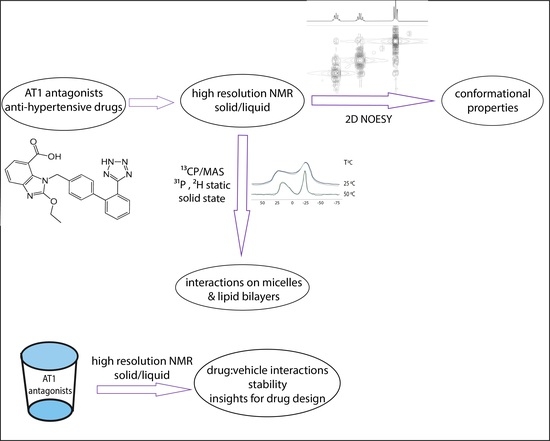On the Rational Drug Design for Hypertension through NMR Spectroscopy
Abstract
1. Introduction
2. Conformational Properties, Drug Action and Stability of AT1R Antagonists in Solvents

3. AT1R Antagonists: Membrane Bilayer Interactions
4. Formulation of AT1R Antagonists with Cyclodextrins
5. Formulation of AT1R Antagonists with Copolymer Micelles
6. Conclusions
Supplementary Materials
Author Contributions
Funding
Conflicts of Interest
References
- Ettehad, D.; Emdin, C.A.; Kiran, A.; Anderson, S.G.; Callender, T.; Emberson, J.; Chalmers, J.; Rodgers, A.; Rahimi, K. Blood pressure lowering for prevention of cardiovascular disease and death: A systematic review and meta-analysis. Lancet 2016, 387, 957–967. [Google Scholar] [CrossRef]
- Wagenaar, L.J.; Voors, A.A.; Buikema, H.; Van Buiten, A.; Lübeck, R.H.; Boonstra, P.W.; Van Veldhuisen, D.J.; Van Gilst, W.H. Functional antagonism of different angiotensin II type I receptor blockers in human arteries. Cardiovasc. Drugs Ther. 2002, 16, 311–316. [Google Scholar] [CrossRef] [PubMed]
- Mendis, S.; Puska, P.; Norrving, B. Global Atlas on Cardiovascular Disease Prevention and Control; World Health Organization: Geneva, Switzerland, 2011; ISBN 9789241564373. [Google Scholar]
- Kellici, T.F.; Tzakos, A.G.; Mavromoustakos, T. Rational drug design and synthesis of molecules targeting the angiotensin II type 1 and type 2 receptors. Molecules 2015, 20, 3868–3897. [Google Scholar] [CrossRef] [PubMed]
- Kellici, T.F.; Liapakis, G.; Tzakos, A.G.; Mavromoustakos, T. Pharmaceutical compositions for antihypertensive treatments: A patent review. Expert Opin. Ther. Pat. 2015, 25, 1–12. [Google Scholar] [CrossRef]
- Mavromoustakos, T.; Agelis, G.; Durdagi, S. AT1 antagonists: A patent review (2008–2012). Expert Opin. Ther. Pat. 2013, 23, 1–12. [Google Scholar] [CrossRef]
- Wingler, L.M.; McMahon, C.; Staus, D.P.; Lefkowitz, R.J.; Kruse, A.C. Distinctive activation mechanism for angiotensin receptor revealed by a synthetic nanobody. Cell 2019, 176, 479–490. [Google Scholar] [CrossRef]
- Zhang, H.; Unal, H.; Gati, C.; Han, G.W.; Liu, W.; Zatsepin, N.A.; James, D.; Wang, D.; Nelson, G.; Weierstall, U.; et al. Structure of the angiotensin receptor revealed by serial femtosecond crystallography. Cell 2015, 161, 833–844. [Google Scholar] [CrossRef]
- Vauquelin, G.; Packeu, A. Ligands, their receptors and... plasma membranes. Mol. Cell. Endocrinol. 2009, 311, 1–10. [Google Scholar] [CrossRef]
- Makriyannis, A.; Tian, X.; Guo, J. How lipophilic cannabinergic ligands reach their receptor sites. Prostaglandins Other Lipid Mediat. 2005, 77, 210–218. [Google Scholar] [CrossRef]
- Mason, R.P.; Rhodes, D.G.; Herbette, L.G.; Mason, R.P.; Mason, R.P.; Rhodes, D.G.; Herbette, L.G.; Herbette, L.G.; Herbette, L.G. Reevaluating equilibrium and kinetic binding parameters for lipophilic drugs based on a structural model for drug interaction with biological membranes. J. Med. Chem. 1991, 34, 869–877. [Google Scholar] [CrossRef] [PubMed]
- Mavromoustakos, T.; Yang, D.P.; Makriyannis, A. Small angle X-ray diffraction and differential scanning calorimetric studies on O-methyl-(-)-Δ8-tetrahydrocannabinol and its 5′ iodinated derivative in membrane bilayers. BBA-Biomembr. 1995, 1237, 183–188. [Google Scholar] [CrossRef][Green Version]
- Mavromoustakos, T.; Zoumpoulakis, P.; Kyrikou, I.; Zoga, A.; Siapi, E.; Zervou, M.; Daliani, I.; Dimitriou, D.; Pitsas, A.; Kamoutsis, C.; et al. Efforts to understand the molecular basis of hypertension through drug: Membrane interactions. Curr. Top. Med. Chem. 2005, 4, 445–459. [Google Scholar] [CrossRef] [PubMed]
- Rhodes, D.G.; Sarmiento, J.G.; Herbette, L.G. Kinetics of binding of membrane-active drugs to receptor sites. Diffusion-limited rates for a membrane bilayer approach of 1,4-dihydropyridine calcium channel antagonists to their active site. Mol. Pharmacol. 1985, 27, 612–623. [Google Scholar] [PubMed]
- Zoumpoulakis, P.; Daliani, I.; Zervou, M.; Kyrikou, I.; Siapi, E.; Lamprinidis, G.; Mikros, E.; Mavromoustakos, T. Losartan’s molecular basis of interaction with membranes and AT 1 receptor. Chem. Phys. Lipids 2003, 125, 13–25. [Google Scholar] [CrossRef]
- Kiriakidi, S.; Chatzigiannis, C.; Papaemmanouil, C.; Tzakos, A.G.; Mavromoustakos, T. Exploring the role of the membrane bilayer in the recognition of candesartan by its GPCR AT1 receptor. Biochim. Biophys. Acta Biomembr. 2020, 1862, 183142. [Google Scholar] [CrossRef]
- Balaz, S. Does transbilayer diffusion have a role in membrane transport of drugs? Drug Discov. Today 2012, 17, 1079–1087. [Google Scholar] [CrossRef]
- Mayne, C.G.; Arcario, M.J.; Mahinthichaichan, P.; Baylon, J.L.; Vermaas, J.V.; Navidpour, L.; Wen, P.C.; Thangapandian, S.; Tajkhorshid, E. The cellular membrane as a mediator for small molecule interaction with membrane proteins. Biochim. Biophys. Acta Biomembr. 2016, 1858, 2290–2304. [Google Scholar] [CrossRef]
- Dobson, P.D.; Kell, D.B. Carrier-mediated cellular uptake of pharmaceutical drugs: An exception or the rule? Nat. Rev. Drug Discov. 2008, 7, 205–220. [Google Scholar] [CrossRef]
- Tian, X.; Guo, J.; Yao, F.; Yang, D.P.; Makriyannis, A. The conformation, location, and dynamic properties of the endocannabinoid ligand anandamide in a membrane bilayer. J. Biol. Chem. 2005, 280, 29788–29795. [Google Scholar] [CrossRef]
- Szlenk, C.T.; Gc, J.B.; Natesan, S. Does the lipid bilayer orchestrate access and binding of ligands to transmembrane orthosteric/allosteric sites of G protein-coupled receptors? Mol. Pharmacol. 2019, 96, 527–541. [Google Scholar] [CrossRef]
- Odoemelam, C.S.; Percival, B.; Wallis, H.; Chang, M.W.; Ahmad, Z.; Scholey, D.; Burton, E.; Williams, I.H.; Kamerlin, C.L.; Wilson, P.B. G-Protein coupled receptors: Structure and function in drug discovery. RSC Adv. 2020, 10, 36337–36348. [Google Scholar] [CrossRef]
- Vauquelin, G. Cell membranes… and how long drugs may exert beneficial pharmacological activity in vivo. Br. J. Clin. Pharmacol. 2016, 82, 673–682. [Google Scholar] [CrossRef] [PubMed]
- D’Amelio, N.; Gaggelli, E.; Gaggelli, N.; Lozzi, L.; Neri, P.; Valensin, D.; Valensin, G. Interaction of angiotensin II with the C-terminal 300–320 fragment of the rat angiotensin II receptor AT1a monitored by NMR. Biopolymers 2003, 70, 134–144. [Google Scholar] [CrossRef] [PubMed]
- Zoumpoulakis, P.; Grdadolnik, S.G.; Matsoukas, J.; Mavromoustakos, T. Structure elucidation and conformational properties of eprosartan a non peptide Angiotensin II AT1 antagonist. J. Pharm. Biomed. Anal. 2002, 28, 125–135. [Google Scholar] [CrossRef]
- Kritsi, E.; Potamitis, C.; Durdagi, S.; Zoumpoulakis, P.; Golic Grdadolnik, S.; Mavromoustakos, T. Molecular insights into the AT1 antagonism based on biophysical and in silico studies of telmisartan. Med. Chem. Res. 2013, 22, 4842–4857. [Google Scholar] [CrossRef]
- Kellici, T.; Ntountaniotis, D.; Kritsi, E.; Zervou, M.; Zoumpoulakis, P.; Potamitis, C.; Durdagi, S.; Salmas, R.; Ergun, G.; Gokdemir, E.; et al. Leveraging NMR and X-ray data of the free ligands to build better drugs targeting angiotensin II Type 1 G-protein coupled receptor. Curr. Med. Chem. 2015, 23, 36–59. [Google Scholar] [CrossRef]
- Li, F.; Wang, L.; Xiao, N.; Yang, M.; Jiang, L.; Liu, M. Dominant conformation of valsartan in sodium dodecyl sulfate micelle environment. J. Phys. Chem. B 2010, 114, 2719–2727. [Google Scholar] [CrossRef]
- Wang, L.; Yan, F. Trans and cis conformations of the antihypertensive drug valsartan respectively lock the inactive and active-like states of angiotensin II type 1 receptor: A molecular dynamics study. J. Chem. Inf. Model. 2018, 58, 2123–2130. [Google Scholar] [CrossRef]
- Singh, K.D.; Unal, H.; Desnoyer, R.; Sadashiva, S.; Foundation, C.C.; States, U. Mechanism of hormone peptide activation of a GPCR: Angiotensin II activated state of AT1R initiated by van der Waals attraction. J. Chem. Inf. Model. 2019, 59, 373–385. [Google Scholar] [CrossRef]
- Wang, J.L.; Zhang, J.; Zhou, Z.M.; Li, Z.H.; Xue, W.Z.; Xu, D.; Hao, L.P.; Han, X.F.; Fei, F.; Liu, T.; et al. Design, synthesis and biological evaluation of 6-substituted aminocarbonyl benzimidazole derivatives as nonpeptidic angiotensin II AT 1 receptor antagonists. Eur. J. Med. Chem. 2012, 49, 183–190. [Google Scholar] [CrossRef]
- Ntountaniotis, D.; Agelis, G.; Resvani, A.; Halabalaki, M.; Liapakis, G.; Spyridaki, K.; Grdadolnik, S.; Merzel, F.; Kostidis, S.; Potamitis, C.; et al. An efficient synthetic method and theoretical calculations of olmesartan methyl ether: Study of biological function of AT1 antagonism. Comb. Chem. High Throughput Screen. 2014, 17, 652–662. [Google Scholar] [CrossRef] [PubMed]
- Wilkes, B.C.; Masaro, L.; Schiller, P.W.; Carpenter, K.A. Angiotensin II vs. its type I antagonists: Conformational requirements for receptor binding assessed from NMR spectroscopic and receptor docking experiments. J. Med. Chem. 2002, 45, 4410–4418. [Google Scholar] [CrossRef] [PubMed]
- Hodzic, A.; Zoumpoulakis, P.; Pabst, G.; Mavromoustakos, T.; Rappolt, M. Losartan’s affinity to fluid bilayers modulates lipid-cholesterol interactions. Phys. Chem. Chem. Phys. 2012, 14, 4780–4788. [Google Scholar] [CrossRef] [PubMed]
- Ntountaniotis, D.; Mali, G.; Grdadolnik, S.G.; Maria, H.; Skaltsounis, A.L.; Potamitis, C.; Siapi, E.; Chatzigeorgiou, P.; Rappolt, M.; Mavromoustakos, T. Thermal, dynamic and structural properties of drug AT 1 antagonist olmesartan in lipid bilayers. Biochim. Biophys. Acta Biomembr. 2011, 1808, 2995–3006. [Google Scholar] [CrossRef] [PubMed]
- Yeagle, P.L. Phosphorus NMR of membranes. In Biological Magnetic Resonance; Springer: Boston, MA, USA, 1990; pp. 1–54. [Google Scholar]
- McLaughlin, A.C.; Cullis, P.R.; Hemminga, M.A.; Hoult, D.I.; Radda, G.K.; Ritchie, G.A.; Seeley, P.J.; Richards, R.E. Application of 31P NMR to model and biological membrane systems. FEBS Lett. 1975, 57, 213–218. [Google Scholar] [CrossRef]
- Hartmann, S.R.; Hahn, E.L. Nuclear double resonance in the rotating frame. Phys. Rev. 1962, 128, 2042. [Google Scholar] [CrossRef]
- Mavromoustakos, T.; Theodoropoulou, E.; Dimitriou, C.; Matsoukas, J.M.; Panagiotopoulos, D.; Makriyannis, A. Interactions of angiotensin II with membranes using a combination of differential scanning calorimetry and 31P NMR spectroscopy. Lett. Pept. Sci. 1996, 3, 175–180. [Google Scholar] [CrossRef]
- Fotakis, C.; Christodouleas, D.; Chatzigeorgiou, P.; Zervou, M.; Benetis, N.P.; Viras, K.; Mavromoustakos, T. Development of a CP 31P NMR broadline simulation methodology for studying the interactions of antihypertensive AT1 antagonist losartan with phospholipid bilayers. Biophys. J. 2009, 96, 2227–2236. [Google Scholar] [CrossRef]
- Benetis, N.P.; Kyrikou, I.; Zervou, M.; Mavromoustakos, T. Static CP 31P NMR multilamellar bilayer broadlines in the absence and presence of the bioactive dipeptide β-Ala-Tyr or Glu. Chem. Phys. 2005, 314, 57–72. [Google Scholar] [CrossRef]
- Fotakis, C.; Christodouleas, D.; Zoumpoulakis, P.; Kritsi, E.; Benetis, N.P.; Mavromoustakos, T.; Reis, H.; Gili, A.; Papadopoulos, M.G.; Zervou, M. Comparative biophysical studies of sartan class drug molecules losartan and candesartan (CV-11974) with membrane bilayers. J. Phys. Chem. B 2011, 115, 6180–6192. [Google Scholar] [CrossRef]
- Fotakis, C.; Megariotis, G.; Christodouleas, D.; Kritsi, E.; Zoumpoulakis, P.; Ntountaniotis, D.; Zervou, M.; Potamitis, C.; Hodzic, A.; Pabst, G.; et al. Comparative study of the AT1 receptor prodrug antagonist candesartan cilexetil with other sartans on the interactions with membrane bilayers. Biochim. Biophys. Acta Biomembr. 2012, 1818, 3107–3120. [Google Scholar] [CrossRef] [PubMed]
- Seelig, A.; Seelig, J. Bilayers of dipalmitoyl-3-sn-phosphatidylcholine. Conformational differences between the fatty acyl chains. BBA Biomembr. 1975, 406, 1–5. [Google Scholar] [CrossRef]
- Ntountaniotis, D.; Kellici, T.; Tzakos, A.; Kolokotroni, P.; Tselios, T.; Becker-Baldus, J.; Glaubitz, C.; Lin, S.; Makriyannis, A.; Mavromoustakos, T. The application of solid-state NMR spectroscopy to study candesartan cilexetil (TCV-116) membrane interactions. Comparative study with the AT1R antagonist drug olmesartan. Biochim. Biophys. Acta Biomembr. 2014, 1838, 2439–2450. [Google Scholar] [CrossRef] [PubMed]
- Popović-Nikolić, M.R.; Popović, G.V.; Grujić, M.; Nikolić, K.M.; Agbaba, D.D. A Theoretical study on ionization of Sartans in aqueous media and on interactions with surfactant micelles. J. Mol. Graph. Model. 2018, 82, 67–73. [Google Scholar] [CrossRef]
- Lula, I.; Denadai, Â.L.; Resende, J.M.; de Sousa, F.B.; de Lima, G.F.; Pilo-Veloso, D.; Heine, T.; Duarte, H.A.; Santos, R.A.S.; Sinisterra, R.D. Study of angiotensin-(1-7) vasoactive peptide and its β-cyclodextrin inclusion complexes: Complete sequence-specific NMR assignments and structural studies. Peptides 2007, 28, 2199–2210. [Google Scholar] [CrossRef]
- Alam, T.; Khan, S.; Gaba, B.; Haider, M.F.; Baboota, S.; Ali, J. Nanocarriers as treatment modalities for hypertension. Drug Deliv. 2017, 24, 358–369. [Google Scholar] [CrossRef]
- De Matos Jensen, C.E.; Dos Santos, R.A.S.; Denadai, A.M.L.; Santos, C.F.F.; Braga, A.N.G.; Sinisterra, R.D. Pharmaceutical composition of valsartan: β-Cyclodextrin: Physico-chemical characterization and anti-hypertensive evaluation. Molecules 2010, 15, 4067–4084. [Google Scholar] [CrossRef]
- De Paula, W.X.; Denadai, Â.M.L.; Santoro, M.M.; Braga, A.N.G.; Santos, R.A.S.; Sinisterra, R.D. Supramolecular interactions between losartan and hydroxypropyl-β-CD: ESI mass-spectrometry, NMR techniques, phase solubility, isothermal titration calorimetry and anti-hypertensive studies. Int. J. Pharm. 2011, 404, 116–123. [Google Scholar] [CrossRef]
- De Paula, W.X.; Denadai, Â.M.L.; Braga, A.N.G.; Shastri, V.P.; Pinheiro, S.V.B.; Frezard, F.; Santos, R.A.S.; Sinisterra, R.D. A long-lasting oral preformulation of the angiotensin II AT1 receptor antagonist losartan. Drug Dev. Ind. Pharm. 2018, 44, 1498–1505. [Google Scholar] [CrossRef]
- Boccellino, M.; Di Domenico, M.; Donniacuo, M.; Bitti, G.; Gritti, G.; Ambrosio, P.; Quagliuolo, L.; Rinaldi, B. AT1-receptor blockade: Protective effects of irbesartan in cardiomyocytes under hypoxic stress. PLoS ONE 2018, 13, e0202297. [Google Scholar] [CrossRef]
- Cheng, Y.Z.; Yang, S.L.; Wang, J.Y.; Ye, M.; Zhuo, X.Y.; Wang, L.T.; Chen, H.; Zhang, H.; Yang, L. Irbesartan attenuates advanced glycation end products-mediated damage in diabetes-associated osteoporosis through the AGEs/RAGE pathway. Life Sci. 2018, 205, 184–192. [Google Scholar] [CrossRef] [PubMed]
- Nakano, Y.; Matoba, T.; Tokutome, M.; Funamoto, D.; Katsuki, S.; Ikeda, G.; Nagaoka, K.; Ishikita, A.; Nakano, K.; Koga, J.I.; et al. Nanoparticle-mediated delivery of irbesartan induces cardioprotection from myocardial ischemia-reperfusion injury by antagonizing monocyte-mediated inflammation. Sci. Rep. 2016, 6. [Google Scholar] [CrossRef] [PubMed]
- Shahin, N.N.; Abdelkader, N.F.; Safar, M.M. A Novel Role of Irbesartan in Gastroprotection against Indomethacin-Induced Gastric Injury in Rats: Targeting DDAH/ADMA and EGFR/ERK Signaling. Sci. Rep. 2018, 8, 4280. [Google Scholar] [CrossRef] [PubMed]
- Wang, X.; Li, G. Irbesartan prevents sodium channel remodeling in a canine model of atrial fibrillation. JRAAS J. Renin Angiotensin Aldosterone Syst. 2018, 19, 1470320318755269. [Google Scholar] [CrossRef]
- Yousef, F. Effect of pH on the complexation of irbesartan with β-, hydroxypropyl-β-, and γ-cyclodextrin: Solubility enhancement and physicochemical characterization. Turk. J. Chem. 2018, 42, 1544–1558. [Google Scholar] [CrossRef]
- Yousif, N.G.; Hadi, N.R.; Al-Amran, F.; Zigam, Q.A. Cardioprotective effects of irbesartan in polymicrobial sepsis: The role of the p38MAPK/NF-κB signaling pathway. HERZ 2018, 43, 140–145. [Google Scholar] [CrossRef]
- Zhang, F.; Zhou, G.; Guo, L.; Lu, F.; Zhou, G. Comparison of clinical efficacy of metoprolol combined with irbesartan and hydrochlorothiazide and non-invasive ventilator in the emergency treatment of patients with severe heart failure. Exp. Ther. Med. 2018, 16, 5059–5066. [Google Scholar] [CrossRef]
- Chontzopoulou, E.; Kyriakidi, S.; Javornik, U.; Plavec, J.; Tzajis, A.; Mavromoustakos, T. NMR Spectroscopy: A valuable tool to study the mechanism of action of AT1 antagonist Irbesartan in Dioleoylphosphatidylcholine Bilayers. (unpublished; manuscript in preparation).
- Liossi, A.S.; Ntountaniotis, D.; Kellici, T.F.; Chatziathanasiadou, M.V.; Megariotis, G.; Mania, M.; Becker-Baldus, J.; Kriechbaum, M.; Krajnc, A.; Christodoulou, E.; et al. Exploring the interactions of irbesartan and irbesartan–2-hydroxypropyl-β-cyclodextrin complex with model membranes. Biochim. Biophys. Acta Biomembr. 2017, 1859, 1089–1098. [Google Scholar] [CrossRef]
- Leonis, G.; Christodoulou, E.; Ntountaniotis, D.; Chatziathanasiadou, M.V.; Mavromoustakos, T.; Naziris, N.; Chountoulesi, M.; Demetzos, C.; Valsami, G.; Damalas, D.E.; et al. Antihypertensive activity and molecular interactions of irbesartan in complex with 2-hydroxypropyl-β-cyclodextrin. Chem. Biol. Drug Des. 2020, 96, 668–683. [Google Scholar] [CrossRef]
- Adams, M.A.; Trudeau, L. Irbesartan: Review of pharmacology and comparative properties. Can. J. Clin. Pharmacol. 2000, 7, 22–31. [Google Scholar]
- Hirlekar, R.; Kadam, V. Preformulation study of the inclusion complex irbesartan-β-cyclodextrin. AAPS PharmSciTech 2009, 10, 276–281. [Google Scholar] [CrossRef] [PubMed]
- Meruva, S.; Thool, P.; Shah, S.; Karki, S.; Bowen, W.; Ghosh, I.; Kumar, S. Formulation and performance of Irbesartan nanocrystalline suspension and granulated or bead-layered dried powders—Part I. Int. J. Pharm. 2019, 568, 1181–1189. [Google Scholar] [CrossRef] [PubMed]
- Ntountaniotis, D.; Andreadelis, I.; Kellici, T.F.; Karageorgos, V.; Leonis, G.; Christodoulou, E.; Kiriakidi, S.; Becker-Baldus, J.; Stylos, E.K.; Chatziathanasiadou, M.V.; et al. Host-guest interactions between candesartan and its prodrug candesartan cilexetil in complex with 2-Hydroxypropyl-β-cyclodextrin: On the biological potency for angiotensin II antagonism. Mol. Pharm. 2019, 16, 1255–1271. [Google Scholar] [CrossRef] [PubMed]
- Soma, D.; Attari, Z.; Reddy, M.S.; Damodaram, A.; Koteshwara, K.B.G. Solid lipid nanoparticles of irbesartan: Preparation, characterization, optimization and pharmacokinetic studies. Braz. J. Pharm. Sci. 2017, 53, 1–10. [Google Scholar] [CrossRef]
- Tamargo, J.; Duarte, J.; Ruilope, L.M. New antihypertensive drugs under development. Curr. Med. Chem. 2014, 22, 305–342. [Google Scholar] [CrossRef]
- Zhang, W.J.; Hong, C.Y.; Pan, C.Y. Polymerization-induced self-assembly of functionalized block copolymer nanoparticles and their application in drug delivery. Macromol. Rapid Commun. 2019, 40, e1800279. [Google Scholar] [CrossRef]
- Kwon, G.S.; Kataoka, K. Block copolymer micelles as long-circulating drug vehicles. Adv. Drug Deliv. Rev. 2012, 64, 237–245. [Google Scholar] [CrossRef]
- Martinho, N.; Damgé, C.; Reis, C.P. Recent advances in drug delivery systems. J. Biomater. Nanobiotechnol. 2011, 2, 510–526. [Google Scholar] [CrossRef]
- Jahangirian, H.; Lemraski, E.G.; Webster, T.J.; Rafiee-Moghaddam, R.; Abdollahi, Y. A review of drug delivery systems based on nanotechnology and green chemistry: Green nanomedicine. Int. J. Nanomedicine 2017, 12, 2957–2978. [Google Scholar] [CrossRef]
- Trivedi, R.; Kompella, U.B. Nanomicellar formulations for sustained drug delivery: Strategies and underlying principles. Nanomedicine 2010, 5, 485–505. [Google Scholar] [CrossRef]
- Imran, M.; Shah, M.R.; Shafi, U. Amphiphilic block copolymers–based micelles for drug delivery. In Design and Development of New Nanocarriers; Elsevier: Amsterdam, the Netherlands, 2018; pp. 365–400. [Google Scholar]
- Gaucher, G.; Dufresne, M.H.; Sant, V.P.; Kang, N.; Maysinger, D.; Leroux, J.C. Block copolymer micelles: Preparation, characterization and application in drug delivery. J. Control. Release 2005, 109, 169–188. [Google Scholar] [CrossRef] [PubMed]
- Adams, M.L.; Lavasanifar, A.; Kwon, G.S. Amphiphilic block copolymers for drug delivery. J. Pharm. Sci. 2003, 92, 1343–1355. [Google Scholar] [CrossRef] [PubMed]
- Mahmud, A.; Xiong, X.B.; Lavasanifar, A. Novel self-associating POly(ethylene oxide)-block-poly(ε-caprolactone) block copolymers with functional side groups on the polyester block for drug delivery. Macromolecules 2006, 10, 471–478. [Google Scholar] [CrossRef]
- Kareem, F.; Bhayo, A.M.; Imran, M.; Shah, M.R.; Khan, K.M.; Malik, M.I. Enhanced therapeutic efficacy of clotrimazole by delivery through poly(ethylene oxide)-block-poly(ε-caprolactone) copolymer-based micelles. J. Appl. Polym. Sci. 2019, 136, 47769. [Google Scholar] [CrossRef]
- Pippa, N.; Kaditi, E.; Pispas, S.; Demetzos, C. PEO-b-PCL-DPPC chimeric nanocarriers: Self-assembly aspects in aqueous and biological media and drug incorporation. Soft Matter 2013, 9, 4073–4082. [Google Scholar] [CrossRef]
- Woodruff, M.A.; Hutmacher, D.W. The return of a forgotten polymer—Polycaprolactone in the 21st century. Prog. Polym. Sci. 2010, 35, 1217–1256. [Google Scholar] [CrossRef]
- Soo, P.L.; Luo, L.; Maysinger, D.; Eisenberg, A. Incorporation and release of hydrophobic probes in biocompatible polycaprolactone-block-poly(ethylene oxide) micelles: Implications for drug delivery. Langmuir 2002, 18, 9996–10004. [Google Scholar] [CrossRef]
- Chroni, A.; Mavromoustakos, T.; Pispas, S. Biocompatible PEO-b-PCL nanosized micelles as drug carriers: Structure and drug–polymer interactions. Nanomaterials 2020, 10, 1892. [Google Scholar] [CrossRef]
- Zervou, M.; Cournia, Z.; Potamitis, C.; Patargias, G.; Durdagi, S.; Grdadolnik, S.G.; Mavromoustakos, T. Insights into the molecular basis of action of the AT1 antagonist losartan using a combined NMR spectroscopy and computational approach. Biochim. Biophys. Acta Biomembr. 2014, 1838, 1031–1046. [Google Scholar] [CrossRef]
- Emwas, A.; Szczepski, K.; Poulson, B.G.; Chandra, K.; Mckay, R.T.; Dhahri, M.; Alahmari, F.; Jaremko, L.; Lachowicz, J.I.; Jaremko, M. NMR as a “gold standard” method in drug design and discovery. Molecules 2020, 25, 4597. [Google Scholar] [CrossRef]
- Raingeval, C.; Cala, O.; Brion, B.; Le Borgne, M.; Hubbard, R.E.; Krimm, I. 1D NMR WaterLOGSY as an efficient method for fragment-based lead discovery. J. Enzyme Inhib. Med. Chem. 2019, 34, 1218–1225. [Google Scholar] [CrossRef] [PubMed]
- Petros, A.M.; Fesik, S.W. Nuclear magnetic resonance methods for studying protein-ligand complexes. Methods Enzymol. 1994, 239, 717–739. [Google Scholar] [PubMed]
- Miranker, A.; Karplus, M. An automated method for dynamic ligand design. Proteins Struct. Funct. Bioinforma. 1995, 23, 472–490. [Google Scholar] [CrossRef] [PubMed]
- Fejzo, J.; Lepre, C.A.; Peng, J.W.; Su, M.S.S.; Thomson, J.A.; Moore, J.M. Dynamic NMR studies of ligand-receptor interactions: Design and analysis of a rapidly exchanging complex of FKBP-12/FK506 with a 24 kDa calcineurin fragment. Protein Sci. 1996, 5, 1917–1921. [Google Scholar] [CrossRef] [PubMed]
- Kay, J.E. Structure-function relationships in the FK506-binding protein (FKBP) family of peptidylprolyl cis-trans isomerases. Biochem. J. 1996, 314, 361–385. [Google Scholar] [CrossRef] [PubMed]
- Theodoropoulou, E.; Marsh, D. Interactions of angiotensin II non-peptide AT1 antagonist losartan with phospholipid membranes studied by combined use of differential scanning calorimetry and electron spin resonance spectroscopy. Biochim. Biophys. Acta Biomembr. 1999, 1461, 135–146. [Google Scholar] [CrossRef][Green Version]
- Theodoropoulou, E.; Marsh, D. Effect of angiotensin II non-peptide AT1 antagonist losartan on phosphatidylethanolamine membranes. Biochim. Biophys. Acta Biomembr. 2000, 1509, 346–360. [Google Scholar] [CrossRef]

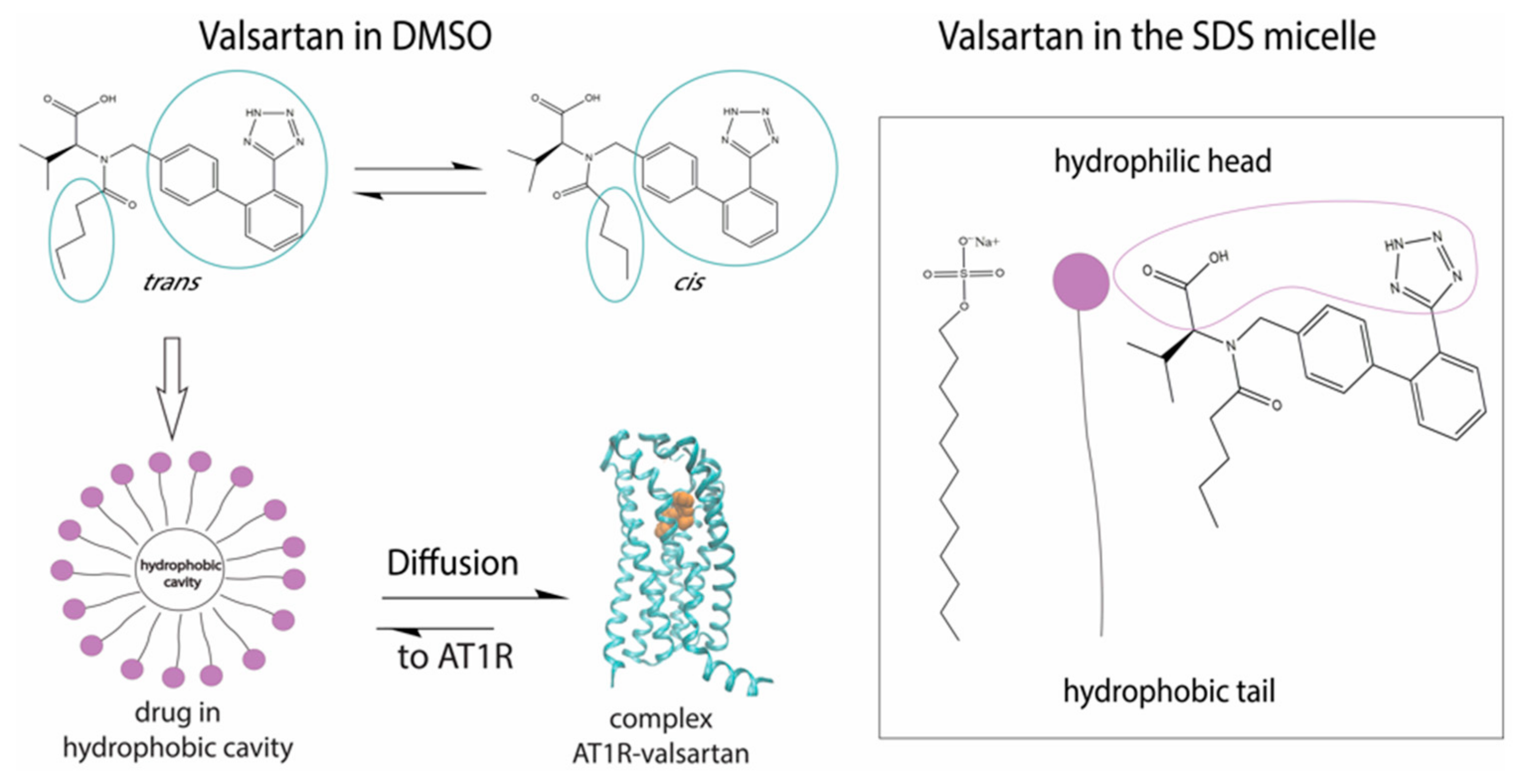



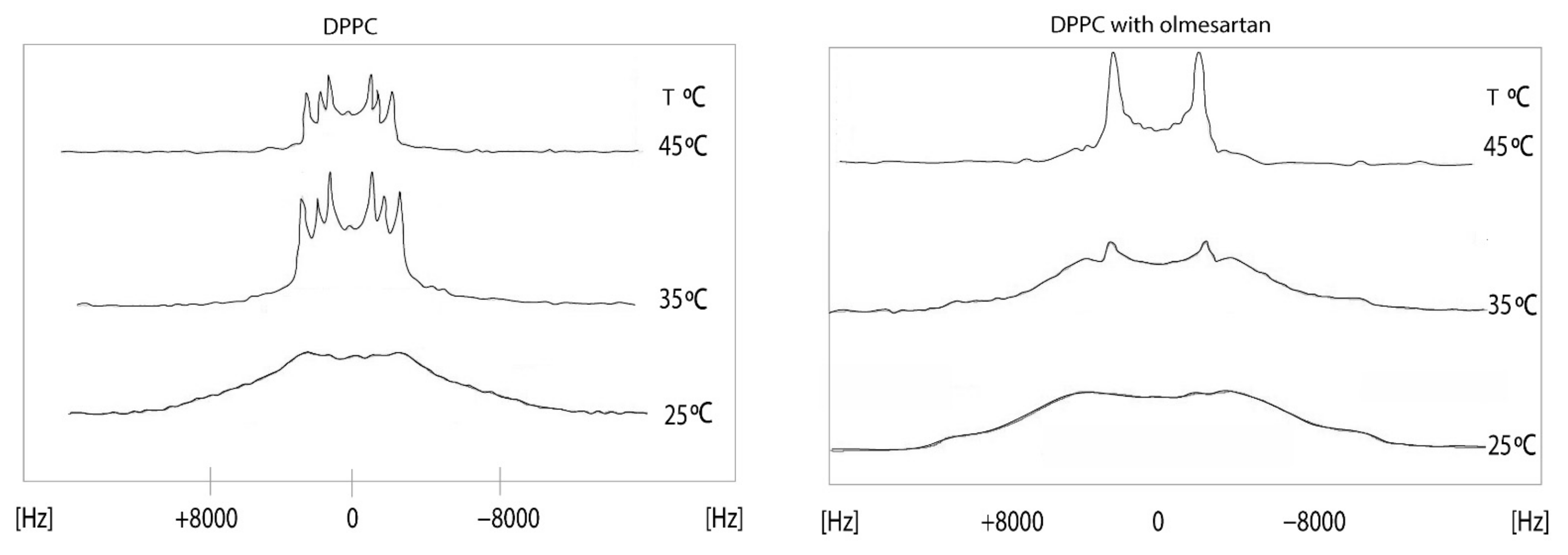
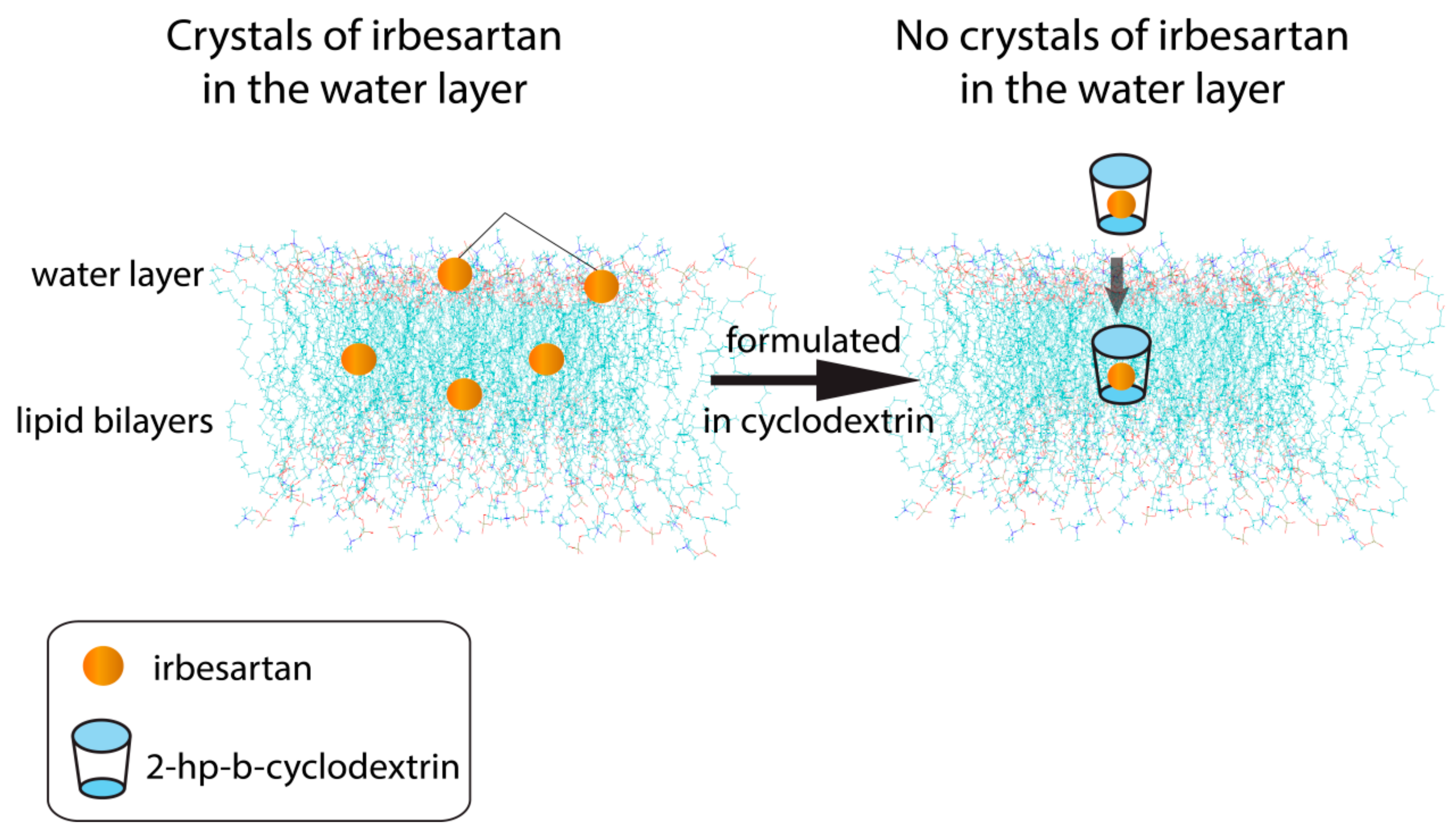
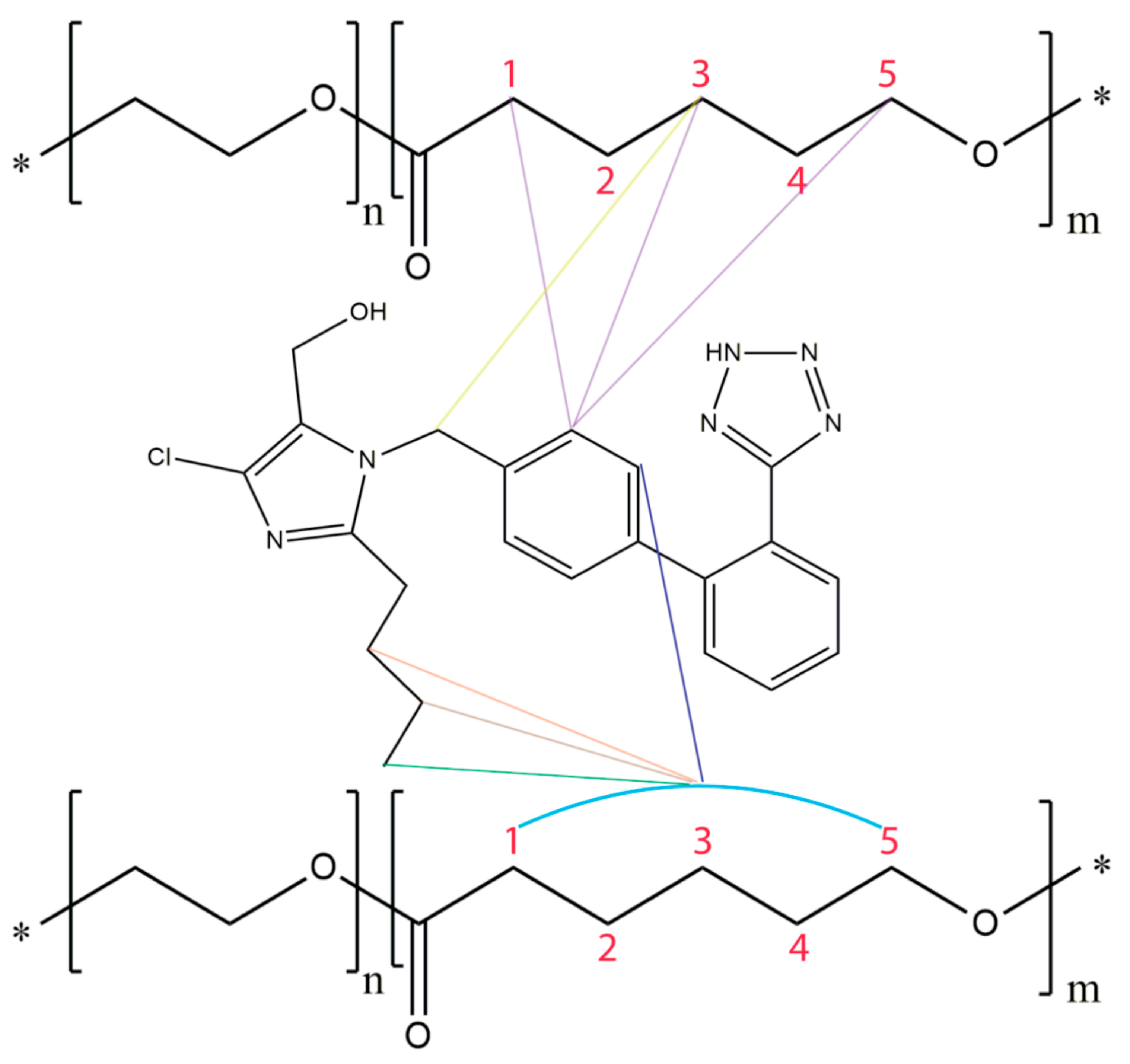
Publisher’s Note: MDPI stays neutral with regard to jurisdictional claims in published maps and institutional affiliations. |
© 2020 by the authors. Licensee MDPI, Basel, Switzerland. This article is an open access article distributed under the terms and conditions of the Creative Commons Attribution (CC BY) license (http://creativecommons.org/licenses/by/4.0/).
Share and Cite
Chontzopoulou, E.; Tzakos, A.G.; Mavromoustakos, T. On the Rational Drug Design for Hypertension through NMR Spectroscopy. Molecules 2021, 26, 12. https://doi.org/10.3390/molecules26010012
Chontzopoulou E, Tzakos AG, Mavromoustakos T. On the Rational Drug Design for Hypertension through NMR Spectroscopy. Molecules. 2021; 26(1):12. https://doi.org/10.3390/molecules26010012
Chicago/Turabian StyleChontzopoulou, Eleni, Andreas G. Tzakos, and Thomas Mavromoustakos. 2021. "On the Rational Drug Design for Hypertension through NMR Spectroscopy" Molecules 26, no. 1: 12. https://doi.org/10.3390/molecules26010012
APA StyleChontzopoulou, E., Tzakos, A. G., & Mavromoustakos, T. (2021). On the Rational Drug Design for Hypertension through NMR Spectroscopy. Molecules, 26(1), 12. https://doi.org/10.3390/molecules26010012






